Metastable Austenitic Steel Structure and Mechanical Properties Evolution in the Process of Cold Radial Forging
Abstract
:1. Introduction
2. Materials and Methods
3. Results
3.1. Structural Study
- Microvolumes of austenite and martensite with a lamellar substructure (indicated by letter A in Figure 3a). However, the number of such areas is relatively small after deformation with e = 1.00, and almost equal to zero after deformation with e = 1.71;
- Microvolumes with block trapezoidal substructure, formed as a result of twinning of austenite in two systems (indicated by letter B in Figure 3a);
- Microvolumes where the transformation of the block trapezoidal substructure into an equiaxed grain structure occurs (indicated by letter C in Figure 3a).
3.2. Hardness Testing
3.3. Tensile Testing
3.4. Impact Strength Testing
4. Discussion
4.1. Evolution of the 321 MASS Structure during CRF
4.1.1. Stages in the Structure Formation Process
4.1.2. Restriction Effect of the Twinning Process
4.1.3. Strain-Induced Martensite Formation
4.2. Mechanical Properties Evolution during CRF
4.2.1. Changes of Hardness and Strength during CRF
4.2.2. Change of Plasticity and Impact Strength Testing during CRF
5. Conclusions
Author Contributions
Funding
Acknowledgments
Conflicts of Interest
References
- Aletdinov, A.; Mironov, S.; Korznikova, G.; Konkova, T.; Zaripova, R.; Myshlyaev, M.; Semiatin, S.L. EBSD investigation of microstructure evolution during cryogenic rolling of type 321 metastable austenitic steel. Mater. Sci. Eng. A 2019, 745, 460–473. [Google Scholar] [CrossRef]
- Talonen, J.; Hänninen, H. Formation of shear bands and strain-induced martensite during plastic deformation of metastable austenitic stainless steels. Acta Mater. 2007, 55, 6108–6118. [Google Scholar] [CrossRef]
- Tiamiyu, A.A.; Odeshi, A.G.; Szpunar, J.A. Multiple strengthening sources and adiabatic shear banding during high strain-rate deformation of AISI 321 austenitic stainless steel: Effects of grain size and strain rate. Mater. Sci. Eng. A 2018, 711, 233–249. [Google Scholar] [CrossRef]
- Eskandari, M.; Hanzaki, A.Z.; Szpunar, J.A.; Bonab, M.A.M.; Kamali, A.R.; Nazarian-Samani, M. Microstructure evolution and mechanical behavior of a new microalloyed High Mn austenitic steel during compressive deformation. Mater. Sci. Eng. A 2014, 615, 424–435. [Google Scholar] [CrossRef]
- Martin, S.; Wolf, S.; Martin, U.; Krüger, L.; Rafaja, D. Deformation mechanisms in austenitic TRIP/TWIP steel as function of temperature. Metall. Mater. Trans. A 2016, 47, 49–58. [Google Scholar] [CrossRef]
- Eskandari, M.; Hanzaki, A.Z.; Bonab, M.A.M.; Onuki, Y.; Basu, R.; Asghari, A.; Szpunar, J.A. Grain-orientation-dependent of γ–ε–α′ transformation and twinning in a super-high-strength, high ductility austenitic Mn-steel. Metall. Mater. Trans. A 2016, 674, 514–528. [Google Scholar] [CrossRef]
- Li, J.; Fang, C.; Liu, Y.; Huang, Z.; Wang, S.; Mao, Q.; Li, Y. Deformation mechanisms of 304L stainless steel with heterogeneous lamella structure. Mater. Sci. Eng. A 2019, 742, 409–413. [Google Scholar] [CrossRef]
- Xu, D.; Wan, X.; Yu, J.; Xu, G.; Li, G. Effect of Cold Deformation on Microstructures and Mechanical Properties of Austenitic Stainless Steel. Metals 2018, 8, 522. [Google Scholar] [CrossRef]
- Litovchenko, I.Y.; Tyumentsev, A.N.; Akkuzin, S.A.; Naiden, E.P.; Korznikov, A.V. Martensitic transformations and the evolution of the defect microstructure of metastable austenitic steel during severe plastic deformation by high-pressure torsion. Phys. Met. Metallogr. 2016, 117, 847–856. [Google Scholar] [CrossRef]
- Xiong, Y.; Yue, Y.; He, T.; Lu, Y.; Ren, F.; Cao, W. Effect of Rolling Temperature to Microstructure Evolution and Mechanical Properties of AISI 316LN Austenitic Stainless Steel. Materials 2018, 11, 1557. [Google Scholar] [CrossRef]
- Odnobokova, M.; Belyakov, A.; Kaibyshev, R. Development of Nanocrystalline 304L Stainless Steel by Large Strain Cold Working. Metals 2015, 5, 656–668. [Google Scholar] [CrossRef]
- Gu, J.; Zhang, L.; Ni, S.; Song, M. Effects of grain size on the microstructures and mechanical properties of 304 austenitic steel processed by torsional deformation. Micron 2018, 105, 93–97. [Google Scholar] [CrossRef]
- Wu, X.L.; Yang, M.X.; Yuan, F.P.; Chen, L.; Zhu, Y.T. Combining gradient structure and TRIP effect to produce austenite stainless steel with high strength and ductility. Acta Mater. 2016, 112, 337–346. [Google Scholar] [CrossRef] [Green Version]
- Huang, C.X.; Yang, G.; Wang, C.; Zhang, Z.F.; Wu, S.D. Mechanical behaviors of ultrafine-grained 301 austenitic stainless steel produced by equal-channel angular pressing. Metall. Mater. Trans. A 2011, 42A, 2061–2071. [Google Scholar] [CrossRef]
- Dobatkin, S.V.; Skrotzki, W.; Rybalchenko, O.V.; Terent’ev, V.F.; Belyakov, A.N.; Prosvirnin, D.V.; Raab, G.I.; Zolotarev, E.V. Structural changes in metastable austenitic steel during equal channel angular pressing and subsequent cyclic deformation. Mater. Sci. Eng. A 2018, 723, 141–147. [Google Scholar] [CrossRef]
- Dobatkin, S.V.; Rybal’chenko, O.V.; Raab, G.I. Structure formation, phase transformations and properties in Cr–Ni austenitic steel after equal-channel angular pressing and heating. Mater. Sci. Eng. A 2007, 463, 41–45. [Google Scholar] [CrossRef]
- Alturk, R.; Luecke, W.E.; Mates, S.; Araujo, A.; Raghavan, K.S.; Abu-Farha, F. Rate effect on transformation kinetics in a metastable austenitic steel. Procedia Eng. 2017, 207, 2006–2011. [Google Scholar] [CrossRef]
- Mirsa, R.D.K.; Wan, X.L.; Challa, V.S.A.; Somani, M.S.; Murr, L.E. Relationship of grain size and deformation mechanism to the fracture behavior in high strength–high ductility nanostructured austenitic stainless steel. Mater. Sci. Eng. A 2015, 626, 41–50. [Google Scholar] [CrossRef]
- Li, C.; Ma, B.; Song, Y.; Li, K.; Dong, J. The Annealing Twins of Fe-20Mn-4Al-0.3C Austenitic Steels during Symmetric and Asymmetric Hot Rolling. Metals 2018, 8, 882. [Google Scholar] [CrossRef]
- Wu, Y.; Dong, X.; Yu, Q. An upper bound solution of axial metal flow in cold radial forging process of rods. Int. J. Mech. Sci. 2014, 85, 120–129. [Google Scholar] [CrossRef]
- Ghaei, A.; Movahhedy, M.R. Die design for the radial forging process using 3D FEM. J. Mater. Process. Technol. 2007, 182, 534–539. [Google Scholar] [CrossRef]
- Du, X.W.; Sun, G.; Nie, C. A Method to Calculate the True Stress and True Strain for Tensile Test of Plastic. Key Eng. Mater. 2004, 274–276, 1077–1082. [Google Scholar] [CrossRef]
- Talonen, J.; Aspegren, P.; Hänninen, H. Comparison of different methods for measuring strain induced α′-martensite content in austenitic steels. Mater. Sci. Technol. 2004, 20, 1506–1512. [Google Scholar] [CrossRef]
- Panov, D.O.; Smirnov, A.I.; Pertsev, A.S. Formation of structure in metastable austenitic steel during cold plastic deformation by the radial forging method. Phys. Met. Metallogr. 2019, 120, 184–190. [Google Scholar] [CrossRef]
- De Dafé, S.S.F.; Sicupira, F.L.; Matos, F.C.S.; Cruz, N.S.; Moreira, D.R.; Santos, D.B. Effect of cooling rate on (ε, α′) martensite formation in twinning/transformation induced plasticity Fe–17Mn–0.06C steel. Mater. Res. 2013, 16, 1229–1236. [Google Scholar] [CrossRef]
- Schramm, R.E.; Reed, R.P. Stacking fault energy of seven commercial austenitic stainless steels. Metall. Trans. A 1975, 6, 1345–1351. [Google Scholar] [CrossRef]
- Rhodes, C.G.; Thompson, A.W. The Composition Dependence of Stacking Fault Energy in Austenitic Stainless Steels. Metall. Trans. A 1977, 8, 1901. [Google Scholar] [CrossRef]
- Bronfman, P.J.; Ansell, G.S. On the Effect of Carbon on the Stacking Fault Energy of Austenitic Stainless Steels. Metall. Mater. Trans. A 1978, 9, 879–880. [Google Scholar] [CrossRef]
- Mahajan, S. Critique of mechanisms of formation of deformation, annealing and growth twins: Face-centered cubic metals and alloys. Scr. Mater. 2013, 68, 95–99. [Google Scholar] [CrossRef]
- Murr, L.E.; Staudhammer, K.P.; Hecker, S.S. Effects of Strain State and Strain Rate on Deformation-Induced Transformation in 304 Stainless Steel: Part II. Microstructural Study. Metall. Trans. A 1982, 13, 627–635. [Google Scholar] [CrossRef]
- Hughes, D.A.; Hansen, N. High angel boundaries formed by grain subdivision mechanisms. Acta Mater. 1997, 45, 3871–3886. [Google Scholar] [CrossRef]
- Lei, C.; Li, X.; Deng, X.; Wang, Z.; Wang, G. Deformation mechanism and ductile fracture behavior in high strength high ductility nano/ultra fine grained Fe-17Cr-6Ni austenitic steel. Mater. Sci. Eng. A 2018, 709, 72–81. [Google Scholar] [CrossRef]
- Zhang, H.; Zhao, Y.; Wang, Y.; Yu, H.; Zhang, C. Fabrication of nanostructure in inner-surface of AISI 304 stainless steel pipe with surface plastic deformation. J. Mater. Sci. Technol. 2018, 34, 2125–2130. [Google Scholar] [CrossRef]
- Chen, M.; Ma, E.; Hemker, K.J.; Sheng, H.; Wang, Y.; Cheng, X. Deformation twinning in nanocrystalline aluminum. Science 2003, 300, 1275–1277. [Google Scholar] [CrossRef]
- Das, Y.B.; Forsey, A.N.; Simm, T.H.; Perkins, K.M.; Fitzpatrick, M.E.; Gungor, S.; Moat, R.J. In situ observation of strain and phase transformation in plastically deformed 301 austenitic stainless steel. Mater. Des. 2016, 112, 107–116. [Google Scholar] [CrossRef] [Green Version]
- Celada-Casero, C.; Kooiker, H.; Groen, M.; Post, J.; San-Martin, D. In-Situ Investigation of Strain-Induced Martensitic Transformation Kinetics in an Austenitic Stainless Steel by Inductive Measurements. Metals 2017, 7, 271. [Google Scholar] [CrossRef]
- Ahmedabadi, P.M.; Kain, V. Modelling kinetics of strain-induced martensite. Mater. Des. 2016, 109, 466–475. [Google Scholar] [CrossRef]
- Carsia-Junceda, A.; Capdevila, C.; Caballero, F.G.; García de Andrés, C. Dependence of martensite start temperature on fine austenite grain size. Scr. Mater. 2008, 58, 134–137. [Google Scholar] [CrossRef] [Green Version]
- Weidner, A.; Hangen, U. Nanoindentation measurements on deformation-induced α-martensite in a metastable austenitic high-alloy CrMnNi steel. Philos. Mag. Lett. 2014, 94, 522–530. [Google Scholar] [CrossRef]
- Lee, S.; Estrin, Y.; De Cooman, B.C. Effect of the strain rate on the TRIP-TWIP transition in austenitic Fe-12 pct Mn-0.6 pct C TWIP Steel. Metall. Mater. Trans. A 2014, 45, 717–730. [Google Scholar] [CrossRef]
- Hall, E.O. The deformation and aging of mild steel: III. Discussion of results. Proc. Phys. Soc. Lond. 1951, 64, 747. [Google Scholar] [CrossRef]
- Petch, N.J. The Cleavage Strength of Polycrystals. J. Iron Steel Inst. 1953, 174, 25. [Google Scholar] [CrossRef]
- Balakhnin, A.N.; Panov, D.O.; Titova, M.G.; Pertsev, A.S.; Simonov, Y.N.; Smirnov, A.I. Effect of cold plastic deformation by radial forging followed by heat treatment on the structure and properties of steel 10KH3G3MF. Met. Sci. Heat Treat. 2013, 54, 576–581. [Google Scholar] [CrossRef]
- Takaki, S.; Fukunaga, K. Effect of grain refinement on thermal stability of metastable austenitic steel. Mater. Trans. 2004, 45, 2245–2251. [Google Scholar] [CrossRef]
- Dobatkin, S.V.; Rybal’chenko, O.V.; Tokar’, A.A.; Kliauga, A. Effect of shear strain on the structure and properties of chromium-nickel corrosion-resistant steels. Met. Sci. Heat Treat. 2015, 57, 222–228. [Google Scholar] [CrossRef]
- Hea, Y.M.; Wanga, Y.H.; Guoa, K.; Wang, T.S. Effect of carbide precipitation on strain-hardening behavior and deformation mechanism of metastable austenitic stainless steel after repetitive cold rolling and reversion annealing. Mater. Sci. Eng. A 2017, 708, 248–253. [Google Scholar] [CrossRef]
- Rezaeia, H.A.; Ghazanib, M.S.; Eghbalia, B. Effect of post deformation annealing on the microstructure and mechanical properties of cold rolled AISI 321 austenitic stainless steel. Mater. Sci. Eng. A 2018, 736, 364–374. [Google Scholar] [CrossRef]
- Goikhenberg, Y.N. Complex hardening of metastable stainless austenitic steels. Met. Sci. Heat Treat. 2015, 56, 477–482. [Google Scholar] [CrossRef]
- Salishchev, G.A.; Zaripova, R.G.; Zakirova, A.A. Structure and properties of stainless steels subjected to severe plastic deformation. Met. Sci. Heat Treat. 2006, 48. [Google Scholar] [CrossRef]
- Maksimkin, O.P.; Tsay, K.V.; Garner, F.A. Inhomogeneity of microstructure, mechanical properties, magnetism, and corrosion observed in a 12Cr18Ni10Ti fuel assembly shroud irradiated in BN-350 to 59 dpa. J. Nucl. Mater. 2015, 467, 899–910. [Google Scholar] [CrossRef]


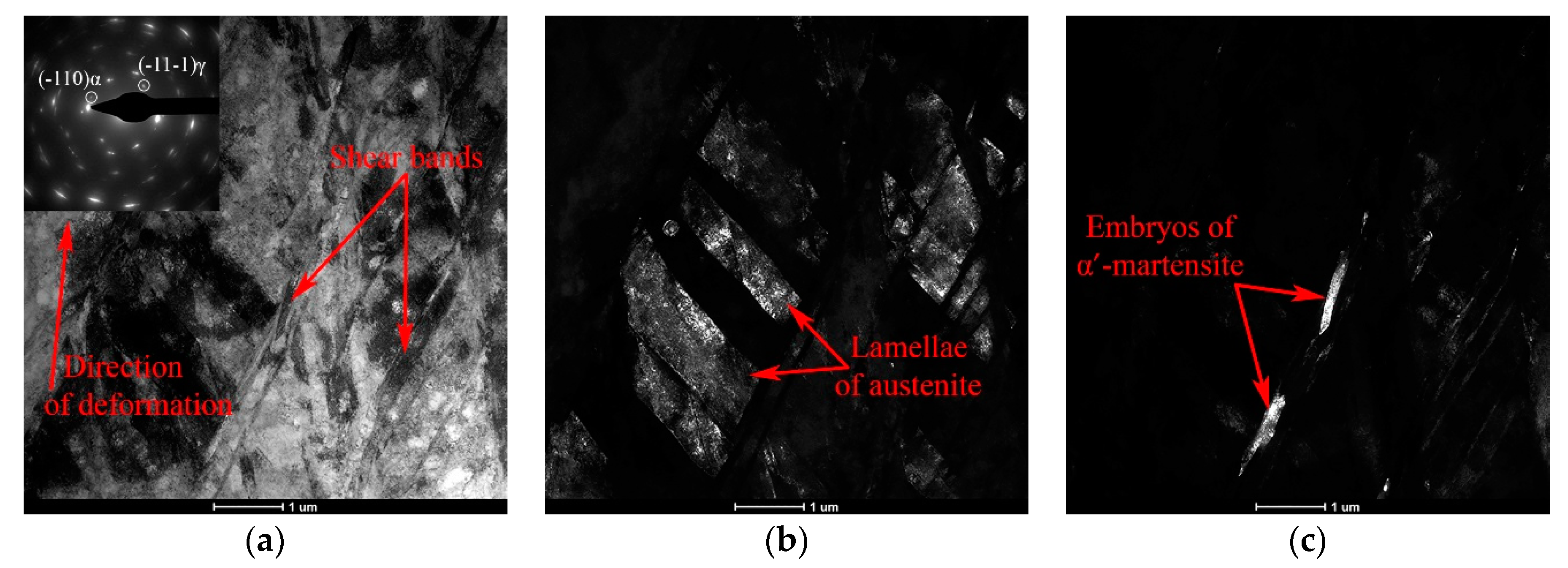
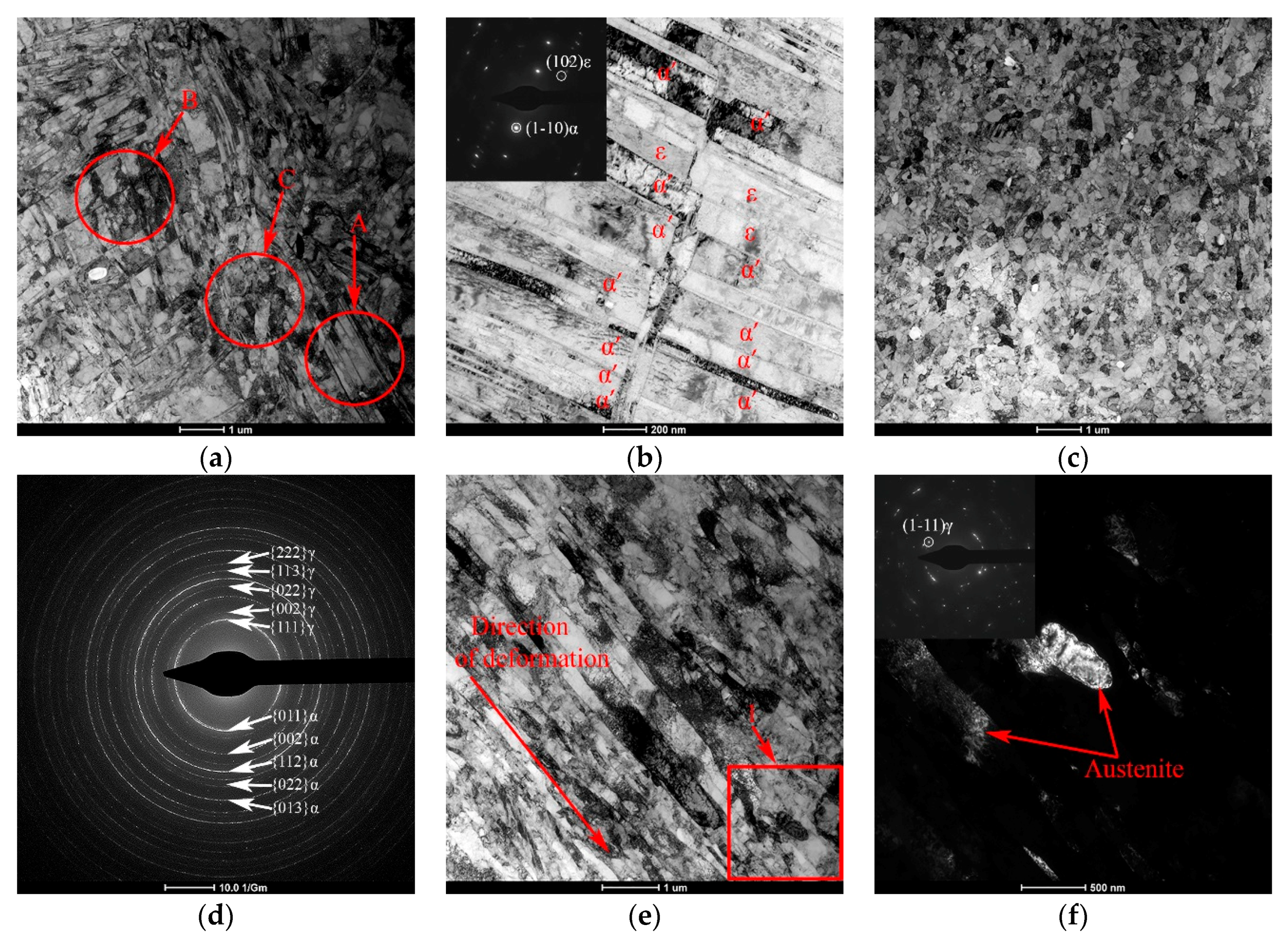
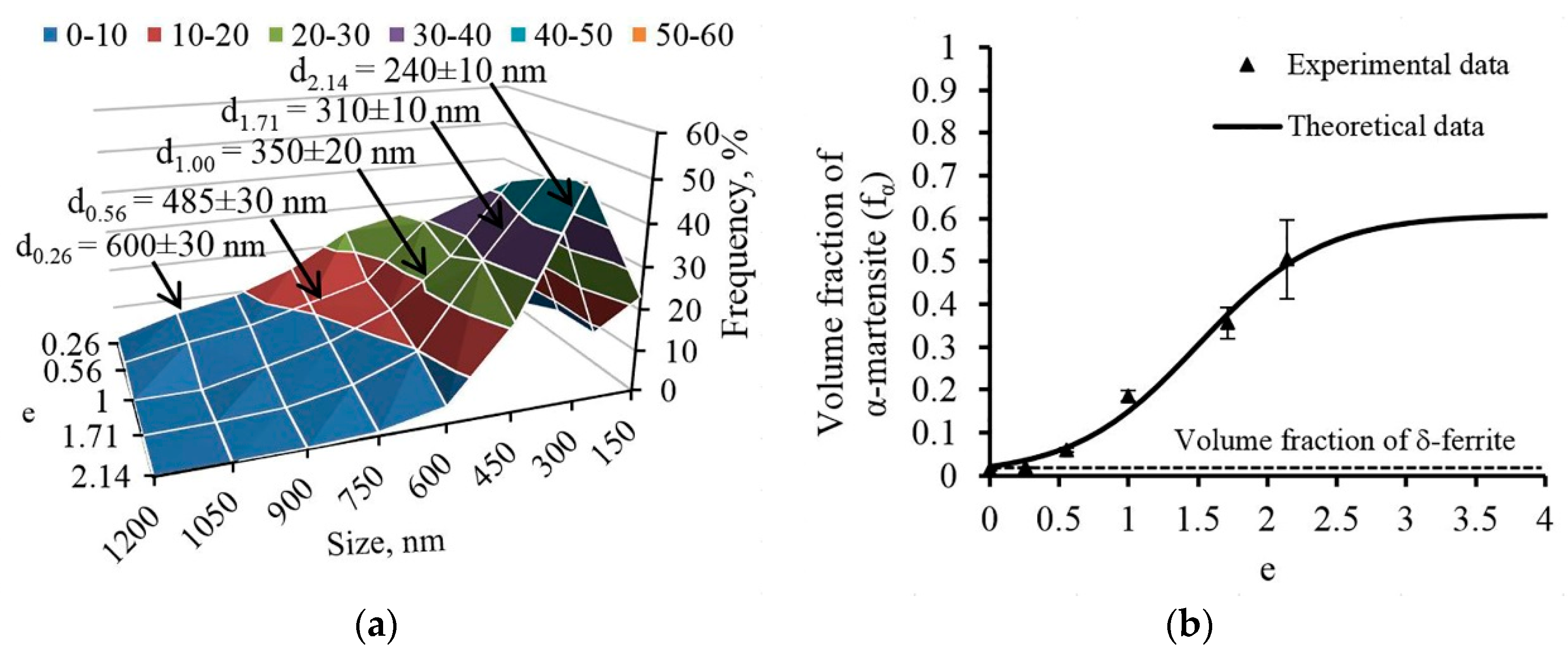

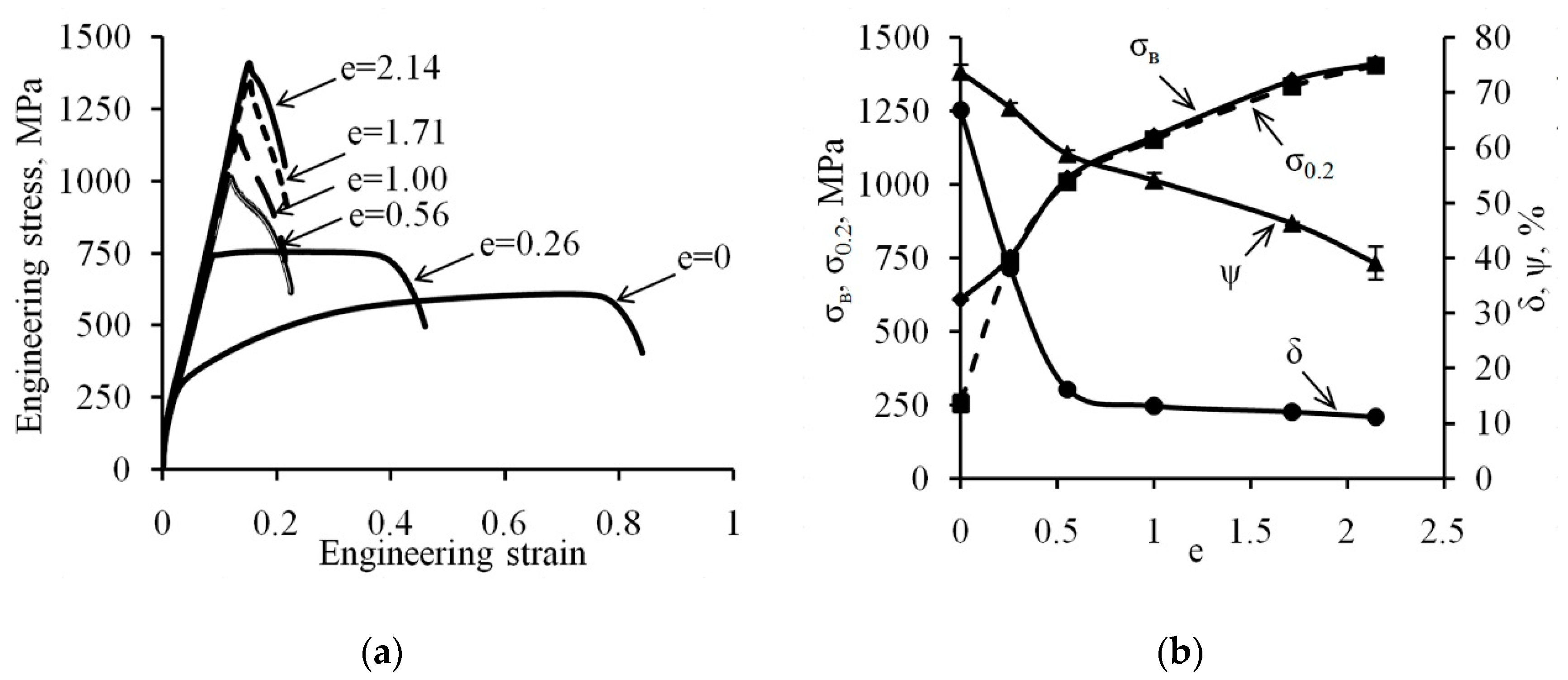

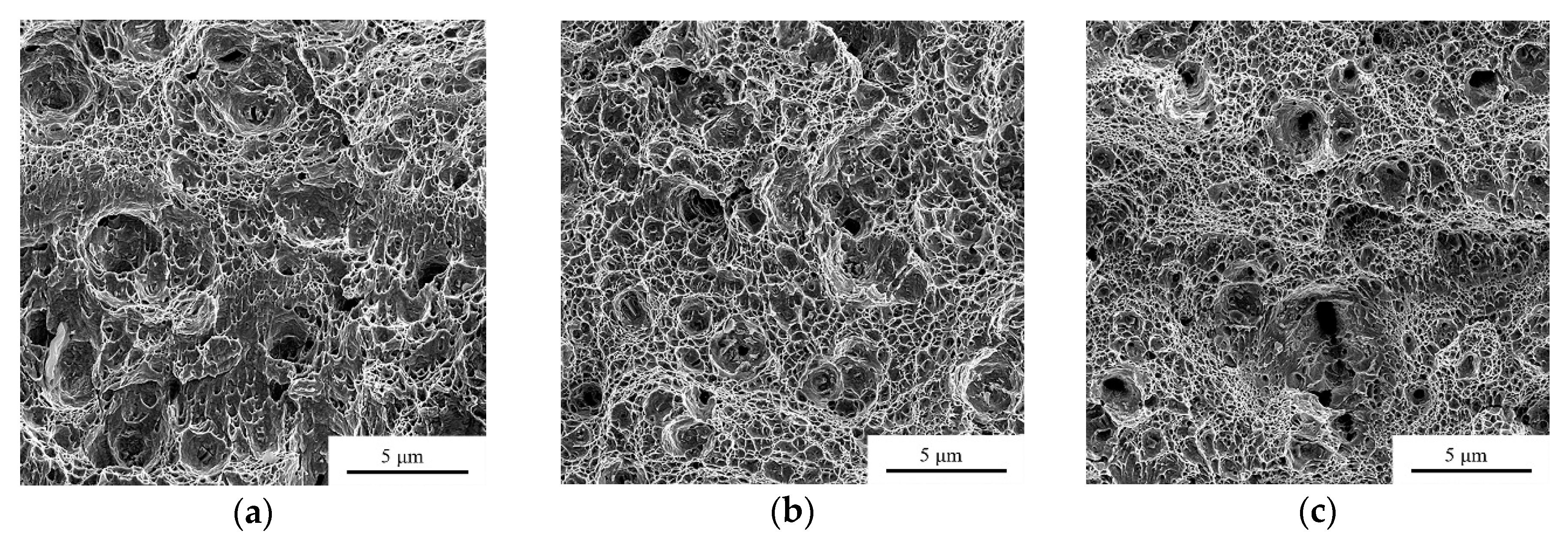
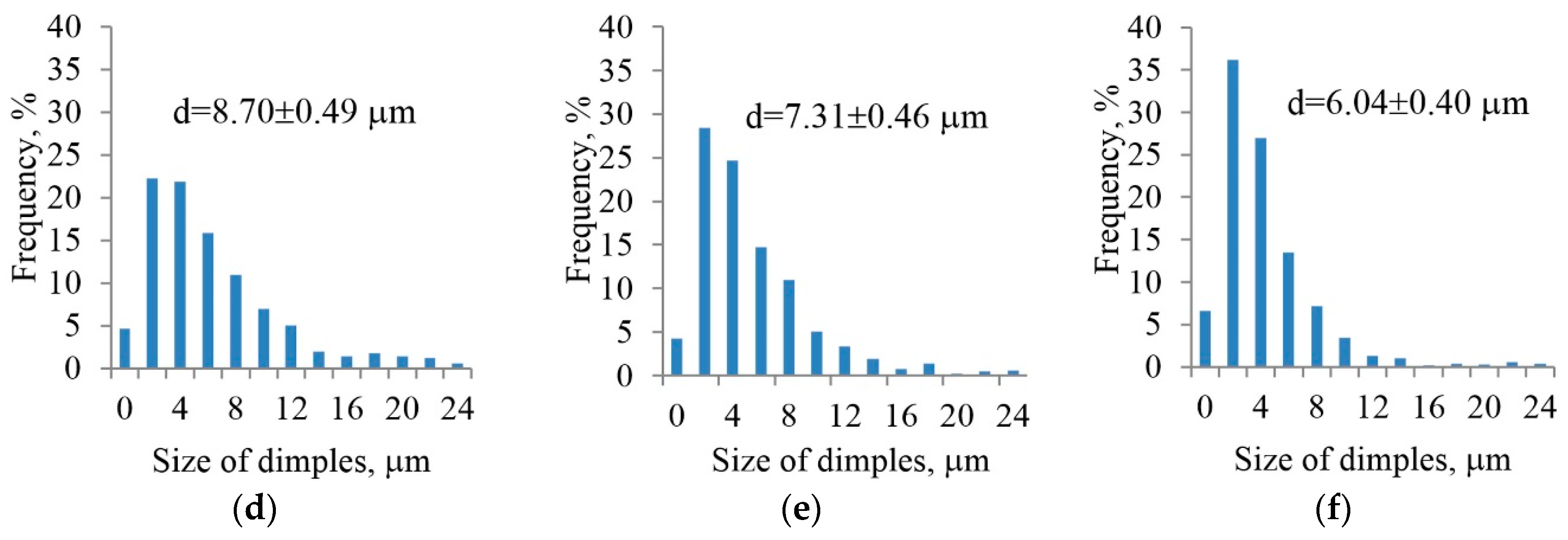
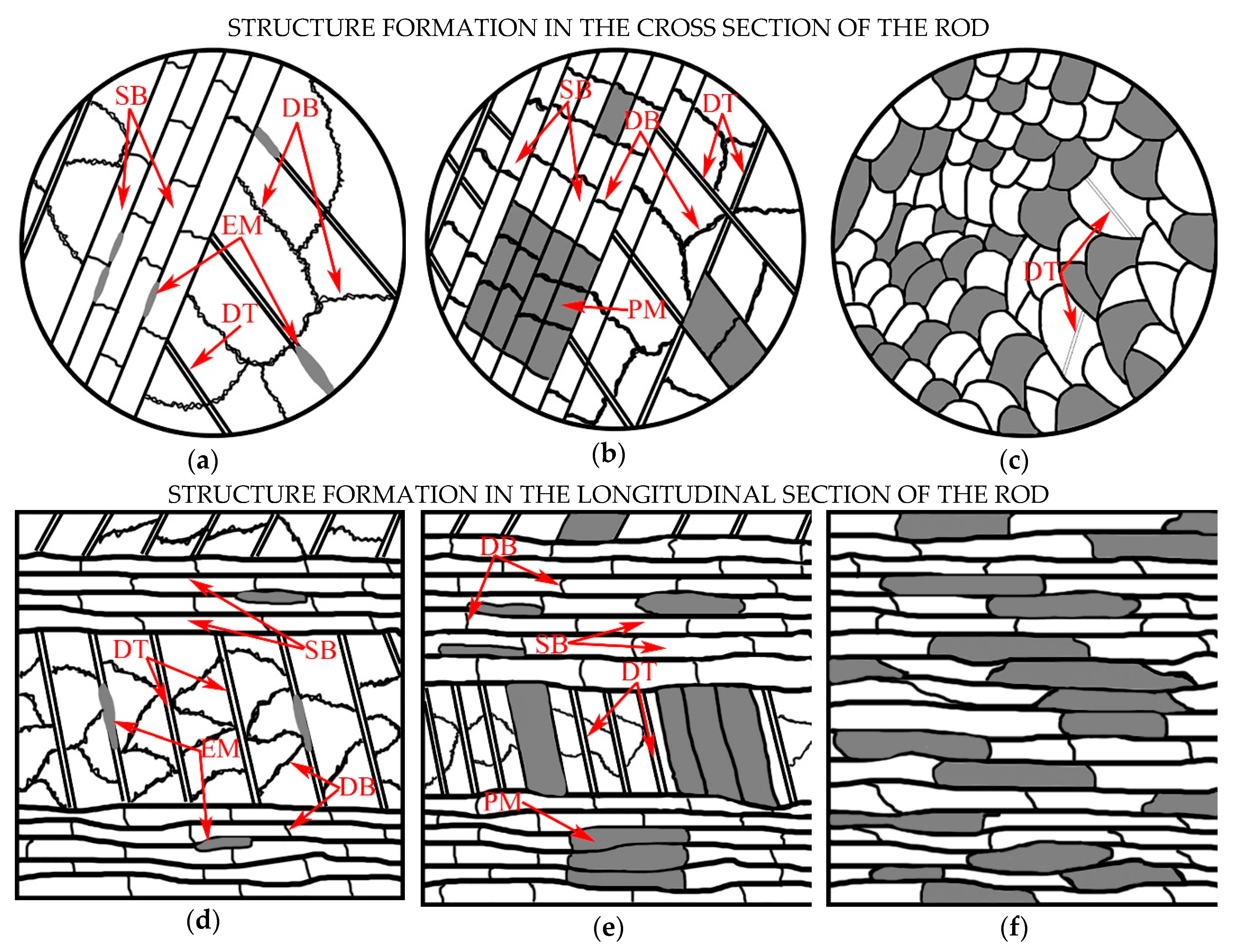

| Grade | C | Si | Mn | P | S | Cr | Ni | Ti | Fe |
|---|---|---|---|---|---|---|---|---|---|
| AISI 321 | ≤0.080 | ≤1.00 | ≤2.0 | ≤0.045 | ≤0.030 | 17.00–19.00 | 9.00–12.00 | 5 × C–0.70 | basis |
| Studied steel | 0.07 | 0.39 | 1.12 | 0.019 | 0.005 | 18.75 | 9.20 | 0.59 | basis |
© 2019 by the authors. Licensee MDPI, Basel, Switzerland. This article is an open access article distributed under the terms and conditions of the Creative Commons Attribution (CC BY) license (http://creativecommons.org/licenses/by/4.0/).
Share and Cite
Panov, D.; Pertsev, A.; Smirnov, A.; Khotinov, V.; Simonov, Y. Metastable Austenitic Steel Structure and Mechanical Properties Evolution in the Process of Cold Radial Forging. Materials 2019, 12, 2058. https://doi.org/10.3390/ma12132058
Panov D, Pertsev A, Smirnov A, Khotinov V, Simonov Y. Metastable Austenitic Steel Structure and Mechanical Properties Evolution in the Process of Cold Radial Forging. Materials. 2019; 12(13):2058. https://doi.org/10.3390/ma12132058
Chicago/Turabian StylePanov, Dmitry, Alexey Pertsev, Alexander Smirnov, Vladislav Khotinov, and Yuri Simonov. 2019. "Metastable Austenitic Steel Structure and Mechanical Properties Evolution in the Process of Cold Radial Forging" Materials 12, no. 13: 2058. https://doi.org/10.3390/ma12132058





